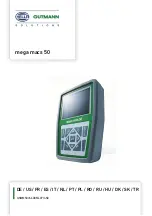
WARNING
To prevent SERIOUS INJURY and DEATH:
1. Wear ANSI-approved safety goggles and
heavy-duty work gloves during setup and use.
2. DO NOT OPEN either Manifold Valve (11) un-
less directed to do so; otherwise, refrigerant
leaks, A/C system contamination, and hazardous
expulsion of pressurized refrigerant may occur.
3. Use in well-ventilated area only.
4. Keep gauge and hoses away from moving
engine parts.
5. Turn off vehicle’s engine and A/C system
before attaching gauge.
6. The following procedure is to be
performed only by a technician certified in
refrigerant recovery and recycling
procedures, as explained previously.
RECOVERY / EVACUATION
1. Close both Manifold Valves (11) by turning
CW. Close both Coupler Valves (22, 23)
by turning CCW.
2. CONNECT HOSES:
a. Connect one end of the Blue Hose (19)
to the Blue LP Hose Connector and the
other end to the Blue Coupler (23).
b. Connect one end of the Red Hose (17)
to the Red LP Hose Connector and the
other end to the Red Coupler (22).
c. Connect one end of the Yellow Hose (18)
to the Yellow Charge Hose Connector (16)
and the other end to the refrigerant
recovery system / vacuum pump.
3. ATTACH COUPLERS:
a. Attach the Blue Coupler (22) to the
suction LP port on the A/C system.
b. Attach the Red Coupler (23) to the
discharge HP port on the A/C system.
4. PERFORM RECOVERY / EVACUATION:
a. Turn on the refrigerant recovery system
/ vacuum pump.
b. Open both Coupler Valves (22, 23) by
turning CW and both Manifold Valves (11),
turning them CCW.
c. Read the amount of vacuum on the
Blue LP Gauge (5).
5. AFTER:
a. Shut off the refrigerant recovery system
/ vacuum pump when the vacuum level
reaches the manufacturer’s recommended
level.
b.
Close both Coupler Valves (22, 23) by
turning CCW.
c. Disconnect the Couplers (22, 23) from
the A/C system. Pull back the knurled ring
on each Coupler (22, 23) and store it on its
Coupler Storage Plug (7 & 6, respectively).
TURN VALVES AS SHOWN ONLY AFTER MAKING
ALL CONNECTIONS AND TURNING ON REFRIG-
ERANT RECOVERY SYSTEM / VACUUM PUMP
CCW
CW
CW
RED
BLUE
YELLOW
To refrigerant recovery
system / vacuum pump
To discharge
HP port
To suction
LP port
CCW


























